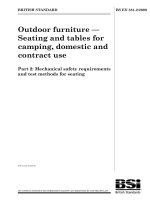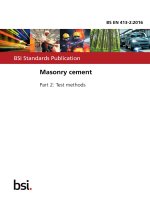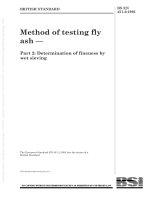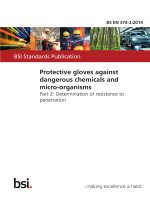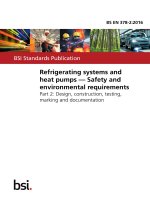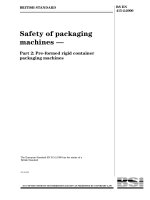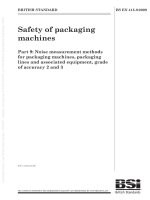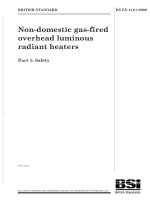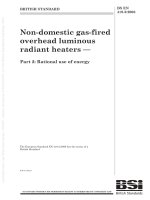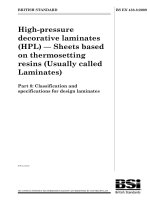Bsi bs en 10028 2 2009
Bạn đang xem bản rút gọn của tài liệu. Xem và tải ngay bản đầy đủ của tài liệu tại đây (380.1 KB, 28 trang )
BRITISH STANDARD
Flat products made
of steels for pressure
purposes
Part 2: Non-alloy and alloy steels
with specified elevated temperature
properties
ICS 77.140.30; 77.140.50
NO COPYING WITHOUT BSI PERMISSION EXCEPT AS PERMITTED BY COPYRIGHT LAW
BS EN
10028-2:2009
BS EN 10028-2:2009
National foreword
This British Standard is the UK implementation of EN 10028-2:2009. It
supersedes BS EN 10028-2:2003 which is withdrawn.
The UK participation in its preparation was entrusted to Technical
Committee ISE/73/2, Steel plates and bars for pressure purposes.
A list of organizations represented on this committee can be obtained on
request to its secretary.
This publication does not purport to include all the necessary provisions
of a contract. Users are responsible for its correct application.
Compliance with a British Standard cannot confer immunity
from legal obligations.
This British Standard
was published under the
authority of the Standards
Policy and Strategy
Committee on 30 June
2009.
© BSI 2009
ISBN 978 0 580 64185 5
Amendments/corrigenda issued since publication
Date
Comments
BS EN 10028-2:2009
EUROPEAN STANDARD
EN 10028-2
NORME EUROPÉENNE
EUROPÄISCHE NORM
June 2009
ICS 77.140.30; 77.140.50
Supersedes EN 10028-2:2003
English Version
Flat products made of steels for pressure purposes - Part 2:
Non-alloy and alloy steels with specified elevated temperature
properties
Produits plats en aciers pour appareils à pression - Partie
2: Aciers non alliés et alliés avec caractéristiques
specifiées à température élevée
Flacherzeugnisse aus Druckbehälterstählen - Teil 2:
Unlegierte und legierte Stähle mit festgelegten
Eigenschaften bei erhöhten Temperaturen
This European Standard was approved by CEN on 14 May 2009.
CEN members are bound to comply with the CEN/CENELEC Internal Regulations which stipulate the conditions for giving this European
Standard the status of a national standard without any alteration. Up-to-date lists and bibliographical references concerning such national
standards may be obtained on application to the CEN Management Centre or to any CEN member.
This European Standard exists in three official versions (English, French, German). A version in any other language made by translation
under the responsibility of a CEN member into its own language and notified to the CEN Management Centre has the same status as the
official versions.
CEN members are the national standards bodies of Austria, Belgium, Bulgaria, Cyprus, Czech Republic, Denmark, Estonia, Finland,
France, Germany, Greece, Hungary, Iceland, Ireland, Italy, Latvia, Lithuania, Luxembourg, Malta, Netherlands, Norway, Poland, Portugal,
Romania, Slovakia, Slovenia, Spain, Sweden, Switzerland and United Kingdom.
EUROPEAN COMMITTEE FOR STANDARDIZATION
COMITÉ EUROPÉEN DE NORMALISATION
EUROPÄISCHES KOMITEE FÜR NORMUNG
Management Centre: Avenue Marnix 17, B-1000 Brussels
© 2009 CEN
All rights of exploitation in any form and by any means reserved
worldwide for CEN national Members.
Ref. No. EN 10028-2:2009: E
BS EN 10028-2:2009
EN 10028-2:2009 (E)
Contents
Page
Foreword ...................................................................................................................................................................... 3
1
Scope .............................................................................................................................................................. 4
2
Normative references .................................................................................................................................... 4
3
Terms and definitions ................................................................................................................................... 4
4
Dimensions and tolerances on dimensions ............................................................................................... 4
5
Calculation of mass ....................................................................................................................................... 4
6
6.1
6.2
Classification and designation ..................................................................................................................... 4
Classification.................................................................................................................................................. 4
Designation .................................................................................................................................................... 4
7
7.1
7.2
7.3
Information to be supplied by the purchaser ............................................................................................. 5
Mandatory information .................................................................................................................................. 5
Options ........................................................................................................................................................... 5
Example for ordering ..................................................................................................................................... 5
8
8.1
8.2
8.3
8.4
8.5
8.6
8.7
8.8
Requirements ................................................................................................................................................. 6
Steelmaking process ..................................................................................................................................... 6
Delivery condition .......................................................................................................................................... 6
Chemical composition .................................................................................................................................. 6
Mechanical properties ................................................................................................................................... 8
Surface condition........................................................................................................................................... 9
Internal soundness ........................................................................................................................................ 9
Resistance to hydrogen induced cracking ................................................................................................. 9
Embrittlement of CrMo steels ....................................................................................................................... 9
9
9.1
9.2
9.3
Inspection ....................................................................................................................................................... 9
Types of inspection and inspection documents ........................................................................................ 9
Tests to be carried out .................................................................................................................................. 9
Retests ............................................................................................................................................................ 9
10
Sampling ......................................................................................................................................................... 9
11
Test methods................................................................................................................................................ 10
12
Marking ......................................................................................................................................................... 10
Annex A (informative) Guidelines for heat treatment ............................................................................................ 15
Annex B (informative) Critical time temperature parameter Pcrit. and possible combinations of stress
relieving temperature and holding time .................................................................................................... 16
Annex C (informative) Reference data of strength values for 1 % (plastic) creep strain and creep
rupture .......................................................................................................................................................... 17
Annex D (normative) Evaluation of resistance to hydrogen induced cracking .................................................. 22
Annex E (normative) Step cooling test ................................................................................................................... 23
Annex ZA (informative) Relationship between this European Standard and the Essential Requirements
of EU Directive 97/23/EC ............................................................................................................................. 24
Bibliography .............................................................................................................................................................. 25
2
BS EN 10028-2:2009
EN 10028-2:2009 (E)
Foreword
This document (EN 10028-2:2009) has been prepared by Technical Committee ECISS/TC 22 “Steels for pressure
purposes - Qualities”, the secretariat of which is held by DIN.
This European Standard shall be given the status of a national standard, either by publication of an identical text or
by endorsement, at the latest by December 2009, and conflicting national standards shall be withdrawn at the latest
by December 2009.
Attention is drawn to the possibility that some of the elements of this document may be the subject of patent rights.
CEN [and/or CENELEC] shall not be held responsible for identifying any or all such patent rights.
This document supersedes EN 10028-2:2003.
This European Standard consists of the following parts, under the general title Flat products made of steels for
pressure purposes:
Part 1: General requirements
Part 2: Non-alloy and alloy steels with specified elevated temperature properties
Part 3: Weldable fine grain steels, normalized
Part 4: Nickel alloy steels with specified low temperature properties
Part 5: Weldable fine grain steels, thermomechanically rolled
Part 6: Weldable fine grain steels, quenched and tempered
Part 7: Stainless steels
NOTE
The clauses marked by two points (••) contain information relating to agreements that may be made at the time of
enquiry and order.
This document has been prepared under a mandate given to CEN by the European Commission and the European
Free Trade Association, and supports essential requirements of EU Directive 97/23/EC.
For relationship with EU Directive 97/23/EC, see informative Annex ZA, which is an integral part of this document.
According to the CEN/CENELEC Internal Regulations, the national standards organizations of the following
countries are bound to implement this European Standard: Austria, Belgium, Bulgaria, Cyprus, Czech Republic,
Denmark, Estonia, Finland, France, Germany, Greece, Hungary, Iceland, Ireland, Italy, Latvia, Lithuania,
Luxembourg, Malta, Netherlands, Norway, Poland, Portugal, Romania, Slovakia, Slovenia, Spain, Sweden,
Switzerland and the United Kingdom.
3
BS EN 10028-2:2009
EN 10028-2:2009 (E)
1
Scope
This European Standard specifies requirements for flat products for pressure equipment made of weldable nonalloy and alloy steels with elevated temperature properties as specified in Table 1.
The requirements and definitions of EN 10028-1:2007 + A1:2009 also apply.
NOTE
Once this European Standard is published in the EU Official Journal (OJEU) under Directive 97/23/EC, presumption of
conformity to the Essential Safety Requirements (ESRs) of Directive 97/23/EC is limited to technical data of materials in this
European Standard (Part 1 and this Part 2 of the series) and does not presume adequacy of the material to a specific item of
equipment. Consequently, the assessment of the technical data stated in this material standard against the design requirements
of this specific item of equipment to verify that the ESRs of Directive 97/23/EC are satisfied, needs to be done.
2
Normative references
The following referenced documents are indispensable for the application of this document. For dated references,
only the edition cited applies. For undated references, the latest edition of the referenced document (including any
amendments) applies.
EN 10028-1:2007 + A1:2009, Flat products made of steels for pressure purposes – Part 1: General requirements
EN 10204:2004, Metallic products – Types of inspection documents
EN 10229:1998, Evaluation of resistance of steel products to hydrogen induced cracking (HIC)
3
Terms and definitions
For the purposes of this document, the terms and definitions given in EN 10028-1:2007 + A1:2009 apply.
4
Dimensions and tolerances on dimensions
See EN 10028-1:2007 + A1:2009.
5
Calculation of mass
See EN 10028-1:2007 + A1:2009.
6
6.1
Classification and designation
Classification
In accordance with EN 10020, the grades P235GH, P265GH, P295GH and P355GH are non-alloy quality steels.
All other grades are alloy special steels.
6.2
Designation
See EN 10028-1:2007 + A1:2009.
4
BS EN 10028-2:2009
EN 10028-2:2009 (E)
7
Information to be supplied by the purchaser
7.1 Mandatory information
See EN 10028-1:2007 + A1:2009.
7.2 Options
A number of options are specified in this European Standard and listed below. Additionally the relevant options of
EN 10028-1:2007 + A1:2009 apply. If the purchaser does not indicate a wish to implement any of these options at
the time of enquiry and order, the products shall be supplied in accordance with the basic specification (see also
EN 10028-1:2007 + A1:2009).
1)
lower copper content and maximum tin content (see Table 1, footnote b);
2)
minimum chromium content of 0,80% (see Table 1, footnote f);
3)
maximum carbon content
Table 1, footnote g);
4)
tests in the simulated normalized condition (see 8.2.2);
5)
delivery conditions deviating from those specified in Table 3 (see 8.2.2 and 8.2.3);
6)
maximum carbon equivalent value for P235GH, P265GH, P295GH and P355GH (see 8.3.3);
7)
specification of a minimum impact energy of 40 J (see Table 3);
8)
mechanical properties for product thicknesses > 250 mm (see Table 3, footnote a);
9)
specification of the delivery condition +QT where the usual delivery condition is +NT (see Table 3, footnote c
and Table 4, footnote c);
of
0,17%
for
product
thicknesses
greater
than
150
mm
(see
10) additional impact energy values (see Table 3, footnote f);
11) Rp0,2 values at elevated temperature for increased product thicknesses (see Table 4, footnote b);
12) HIC test in accordance with EN 10229 (see 8.7);
13) step cooling test in accordance with Annex E (see 8.8);
14) mid thickness test pieces for the impact test (see Clause 10);
7.3 Example for ordering
10 plates with nominal dimensions, thickness = 50 mm, width = 2 000 mm, length = 10 000 mm, made of a steel
grade with the name 16Mo3 and the number 1.5415 as specified in EN 10028-2, to be delivered untreated,
inspection document 3.1 as specified in EN 10204:
10 plates – 50 x 2 000 x 10 000 – EN 10028-2 16Mo3+AR - Inspection document 3.1
or
10 plates – 50 x 2 000 x 10 000 – EN 10028-2 1.5415+AR – Inspection document 3.1.
5
BS EN 10028-2:2009
EN 10028-2:2009 (E)
8
Requirements
8.1 Steelmaking process
See EN 10028-1:2007 + A1:2009.
8.2 Delivery condition
8.2.1 Unless otherwise agreed at the time of enquiry and order, the products covered by this European Standard
shall be supplied in the usual conditions given in Table 3 (see 8.2.3).
8.2.2 •• Normalizing may, at the discretion of manufacturer, be replaced with normalizing rolling for the steel
grades P235GH, P265GH, P295GH and P355GH. In this case, additional tests in the simulated normalized
condition with an agreed frequency of testing may be agreed at the time of enquiry and order to verify that the
specified properties are complied with.
8.2.3 •• If so agreed at the time of enquiry and order, products made of steel grades P235GH, P265GH,
P295GH, P355GH and 16Mo3 may also be delivered in the untreated condition. Products made of one of the other
alloy grades may be supplied in the tempered or normalized condition or, in exceptional cases, in the untreated
condition if so agreed (Annex A contains heat treatment information for the purchaser).
In these cases, testing shall be carried out on test pieces in the usual delivery condition as indicated in Table 3.
NOTE
The testing of the test pieces in a simulated heat treated condition does not discharge the processor from the
obligation of providing proof of the specified properties in the finished product.
8.2.4
Information on welding is given in EN 1011-1 and EN 1011-2.
NOTE
Excessive post weld heat treatment (PWHT) conditions can decrease the mechanical properties. When in stress
relieving the intended time temperature parameter
-3
P = Ts (20 + lg t) ⋅ 10 ,
where
Ts is the stress relieving temperature in K and
T is the holding time in hours,
exceeds the critical (Pcrit.) values in Annex B, the purchaser should in his enquiry and order inform the manufacturer accordingly
and, where appropriate, tests on simulated heat treated samples can be agreed to check whether after such a treatment the
properties specified in this document can still be regarded as valid.
8.3 Chemical composition
8.3.1
The requirements of Table 1 shall apply for the chemical composition according to the cast analysis.
8.3.2 The product analysis shall not deviate from the specified values for the cast analysis as specified in Table 1
by more than the values given in Table 2.
8.3.3 •• A maximum value for the carbon equivalent may be agreed upon at the time of enquiry and order for
steel grades P235GH, P265GH, P295GH and P355GH. In this case, the following formula shall apply for
calculation of the carbon equivalent value (CEV):
CEV = C +
6
Mn Cr +Mo + V Ni+Cu
+
+
6
5
15
EN 10028-2:2009 (E)
Table 1 — Chemical composition (cast analysis) a
Steel grade
Steel name
% by mass
Steel number
P235GH
1.0345
C
≤ 0,16
Si
≤ 0,35
Mn
0,60c to 1,20
P
S
max.
max.
Altotal
N
Cr
Cub
Mo
Nb
Ni
Ti
V
Others
max.
d
≤ 0,30
≤ 0,30
≤ 0,08
≤ 0,020
≤ 0,30
0,03
≤ 0,02
d
≤ 0,30
≤ 0,30
≤ 0,08
≤ 0,020
≤ 0,30
0,03
≤ 0,02
d
≤ 0,30
≤ 0,30
≤ 0,08
≤ 0,020
≤ 0,30
0,03
d
0,025
0,010
≥ 0,020
≤ 0,012
c
0,025
0,010
≥ 0,020
≤ 0,012
c
P265GH
1.0425
≤ 0,20
≤ 0,40
0,80 to 1,40
P295GH
1.0481
0,08 to 0,20
≤ 0,40
0,90 to 1,50
0,025
0,010
≥ 0,020
≤ 0,012
≤ 0,02
Cr+Cu+Mo+
P355GH
1.0473
0,10 to 0,22
≤ 0,60
1,10 to 1,70
0,025
0,010
≥ 0,020
≤ 0,012
≤ 0,30
≤ 0,30
≤ 0,08
≤ 0,040
≤ 0,30
0,03
≤ 0,02
Ni: ≤ 0,70
16Mo3
1.5415
0,12 to 0,20
≤ 0,35
0,40 to 0,90
0,025
0,010
e
≤ 0,012
≤ 0,30
≤ 0,30
0,25 to 0,35
-
≤ 0,30
-
-
-
18MnMo4-5
1.5414
≤ 0,20
≤ 0,40
0,90 to 1,50
0,015
0,005
e
≤ 0,012
≤ 0,30
≤ 0,30
0,45 to 0,60
-
≤ 0,30
-
-
-
20MnMoNi4-5
1.6311
0,15 to 0,23
≤ 0,40
1,00 to 1,50
0,020
0,010
e
≤ 0,012
≤ 0,20
≤ 0,20
0,45 to 0,60
-
0,40 to 0,80
-
≤ 0,02
-
15NiCuMoNb5-6-4
1.6368
≤ 0,17
0,25 to 0,50
0,80 to 1,20
0,025
0,010
≥ 0,015
≤ 0,020
≤ 0,30
0,50 to 0,80
0,25 to 0,50
0,015
0,045
1,00 to 1,30
-
-
-
13CrMo4-5
1.7335
0,08 to 0,18
≤ 0,35
0,40 to 1,00
0,025
0,010
e
≤ 0,012
0,70f to 1,15
≤ 0,30
0,40 to 0,60
-
-
-
-
-
13CrMoSi5-5
1.7336
≤ 0,17
0,50 to 0,80
0,40 to 0,65
0,015
0,005
e
≤ 0,012
1,00 to 1,50
≤ 0,30
0,45 to 0,65
-
≤0,30
-
-
-
10CrMo9-10
1.7380
0,08 to 0,14g
≤ 0,50
0,40 to 0,80
0,020
0,010
e
≤ 0,012
2,00 to 2,50
≤ 0,30
0,90 to 1,10
-
-
-
-
-
≤ 0,30
-
-
-
to
12CrMo9-10
1.7375
0,10 to 0,15
≤ 0,30
0,30 to 0,80
0,015
0,010
0,010
to
0,040
≤ 0,012
2,00 to 2,50
≤ 0,25
0,90 to 1,10
-
X12CrMo5
1.7362
0,10 to 0,15
≤ 0,50
0,30 to 0,60
0,020
0,005
e
≤ 0,012
4,0 to 6,0
≤ 0,30
0,45 to 0,65
-
≤ 0,30
-
-
-
13CrMoV9-10
1.7703
0,11 to 0,15
≤ 0,10
0,30 to 0,60
0,015
0,005
e
≤ 0,012
2,00 to 2,50
≤ 0,20
0,90 to 1,10
≤ 0,07
≤ 0,25
0,03
0,25 to 0,35
B ≤ 0,002,
12CrMoV12-10
1.7767
0,10 to 0,15
≤ 0,15
0,30 to 0,60
0,015
0,005
e
≤ 0,012
2,75 to 3,25
≤ 0,25
0,90 to 1,10
≤ 0,07
≤ 0,25
0,03
0,20 to 0,30
B ≤ 0,003h,
Ca ≤ 0,015
h
h
Ca ≤ 0,015h
X10CrMoVNb9-1
a
b
c
d
e
f
g
h
1.4903
0,08 to 0,12
≤ 0,50
0,30 to 0,60
0,020
0,005
≤ 0,040
0,030 to 0,070
8,0 to 9,5
≤ 0,30
0,85 to 1,05
0,06 to 0,10
≤ 0,30
-
0,18 to 0,25
-
Elements not listed in this table shall not be intentionally added to the steel without the agreement of the purchaser except for finishing the cast. All appropriate measures shall be taken to prevent the addition from scrap
or other materials used in steelmaking of these elements which may affect the mechanical properties and usability.
•• A lower maximum copper content and/or a maximum sum of copper and tin content, e.g. Cu + 6 Sn ≤ 0,33%, may be agreed upon at the time of enquiry and order, e.g. wi h regard to hot formability for the grades where only a
maximum copper content is specified.
For product thicknesses < 6 mm, a minimum manganese content of 0,20 % lower than specified is permitted.
A ratio
Al
N
≥ 2 shall apply.
The Al content of the cast shall be determined and given in the inspec ion document.
•• If resistance to pressurized hydrogen is of importance, a minimum content of 0,80% Cr may be agreed upon at the time of enquiry and order.
•• For product hicknesses greater than 150 mm, a maximum content of 0,17% C may be agreed upon at the time of enquiry and order.
This grade may be produced with additions of either Ti + B or Nb + Ca. The following minimum contents shall apply: Ti ≥ 0,015 % and B ≥ 0,001 % in he case of additions of Ti + B, Nb ≥ 0,015 % and Ca ≥ 0,0005 % in the case of
additions of Nb + Ca.
7
BS EN 10028-2:2009
EN 10028-2:2009 (E)
Table 2 — Permissible product analysis tolerances on the limiting values given in Table 1
for the cast analysis
Element
a
Specified value in the cast
analysis according to Table 1
Permissible deviation of the product
analysis
% by mass
% by mass
C
≤ 0,23
± 0,02
Si
≤ 0,35
± 0,05
> 0,35 to ≤ 1,00
± 0,06
≤ 1,00
± 0,05
> 1,00 to ≤ 1,70
± 0,10
≤ 0,015
+ 0,003
> 0,015 to ≤ 0,025
+ 0,005
S
≤ 0,010
+ 0,003
Al
≥ 0,010
± 0,005
B
≤ 0,003
± 0,0005
N
≤ 0,020
+ 0,002
> 0,020 to ≤ 0,070
± 0,005
≤ 2,00
± 0,05
> 2,00 to ≤ 10,0
± 0,10
≤ 0,30
± 0,05
> 0,30 to ≤ 0,80
± 0,10
≤ 0,35
± 0,03
> 0,35 to ≤ 1,10
+ 0,04
Nb
≤ 0,10
± 0,01
Ni
≤ 0,30
+ 0,05
> 0,30 to ≤ 1,30
± 0,10
Cr+Cu+Mo+Ni
≤ 0,70
+ 0,05
Ti
=< 0,03
± 0,01
V
=< 0,05
± 0,01
> 0,05 to ≤ 0,30
± 0,03
Mn
P
Cr
Cu
Mo
a
If several product analyses are carried out on one cast, and the contents of an individual
element determined lie outside the permissible range of the chemical composition specified
for the cast analysis then it is only allowed to exceed the permissible maximum value or fall
short of the permissible minimum value, but not both for one cast.
8.4 Mechanical properties
8.4.1
apply.
The values given in Tables 3 and 4 (see also EN 10028-1:2007 + A1:2009 and Clause 10) shall
8.4.2
Annex C gives mean values as preliminary data for the purchaser about 1% (plastic) creep strain
and creep rupture.
8
BS EN 10028-2:2009
EN 10028-2:2009 (E)
8.5 Surface condition
See EN 10028-1:2007 + A1:2009.
8.6 Internal soundness
See EN 10028-1:2007 + A1:2009.
For possible verification of internal soundness, see also EN 10028-1:2007 + A1:2009.
8.7 Resistance to hydrogen induced cracking
Carbon and low alloy steels may be susceptible to cracking when exposed to corrosive H2S containing
environments, usually referred to as 'sour service'.
•• A test to evaluate the resistance to hydrogen induced cracking in accordance with Annex D may be
specified at the time of enquiry and order.
8.8 Embrittlement of CrMo steels
CrMo steels may tend to become brittle in service at temperatures between approximately 400 °C and
°
500 C. This possible tendency for embrittlement can be simulated in the laboratory with the so called
step cooling test. In this test a specimen is exposed to a temperature - time cycle as given in Figure E.1.
The shift of a transition curve caused by the step cooling test is a measure for the embrittlement.
••• A step cooling test in accordance with Annex E may be specified at the time of
enquiry and order.
9
Inspection
9.1 Types of inspection and inspection documents
See EN 10028-1:2007 + A1:2009.
9.2 Tests to be carried out
See EN 10028-1:2007 + A1:2009 and 8.7 and 8.8.
9.3 Retests
See EN 10028-1:2007 + A1:2009
10 Sampling
See EN 10028-1:2007 + A1:2009.
•• For the impact test, deviating from EN 10028-1:2007 + A1:2009, Table 3, footnote f, the preparation of
test pieces taken from the mid thickness may be agreed at the time of enquiry and order. In this case, test
temperatures and minimum impact energy values shall also be agreed.
9
BS EN 10028-2:2009
EN 10028-2:2009 (E)
11 Test methods
See EN 10028-1:2007 + A1:2009, and Annexes D and E.
12 Marking
See EN 10028-1:2007 + A1:2009.
10
BS EN 10028-2:2009
EN 10028-2:2009 (E)
Table 3 — Mechanical properties (applicable to the transverse direction)a
Tensile properties at room
temperature
Steel grade
Steel name
P235GH
P265GH
P295GH
P355GH
Usual
delivery
conditionb,c
Steel
number
1.0345
1.0425
1.0481
1.0473
16Mo3
1.5415
18MnMo4-5
1.5414
+N
d
+Nd
+Nd
+Nd
+N
e
+NT
+QT
20MnMoNi4-5
1.6311
+QT
+NT
15NiCuMoNb
5-6-4
1.6368
+NT or +QT
+QT
Product
thickness
t
Yield
strength
ReH
mm
MPa
min.
≤ 16
16 < t ≤ 40
40 < t ≤ 60
60 < t ≤ 100
100 < t ≤ 150
150 < t ≤ 250
≤ 16
16 < t ≤ 40
40 < t ≤ 60
60 < t ≤ 100
100 < t ≤ 150
150 < t ≤ 250
≤ 16
16 < t ≤ 40
40 < t ≤ 60
60 < t ≤ 100
100 < t ≤ 150
150 < t ≤ 250
≤ 16
16 < t ≤ 40
40 < t ≤ 60
60 < t ≤ 100
100 < t ≤ 150
150 < t ≤ 250
≤ 16
16 < t ≤ 40
40 < t ≤ 60
60 < t ≤ 100
100 < t ≤ 150
150 < t ≤ 250
≤ 60
60 < t ≤ 150
150 < t ≤ 250
≤ 40
40 < t ≤ 60
60 < t ≤ 100
100 < t ≤ 150
150 < t ≤ 250
≤ 40
40 < t ≤ 60
60 < t ≤ 100
100 < t ≤ 150
150 < t ≤ 200
235
225
215
200
185
170
265
255
245
215
200
185
295
290
285
260
235
220
355
345
335
315
295
280
275
270
260
240
220
210
345
325
310
470
460
450
440
400
460
440
430
420
410
Tensile
strength
Rm
MPa
Impact energy KV
J
min.
at a temperature in °C of
Elongation after
fracture
A
–20
0
+20
24
27 g
34 g
40
22
27 g
34 g
40
21
27 g
34 g
40
20
27 g
34 g
40
22
f
f
31g
20
27 g
34 g
40
18
27 g
40
50
16
27 g
34 g
40
%
min.
360 to 480
350 to 480
340 to 480
410 to 530
400 to 530
390 to 530
460 to 580
440 to 570
430 to 570
510 to 650
490 to 630
480 to 630
470 to 630
440 to 590
430 to 580
420 to 570
410 to 570
510 to 650
480 to 620
590 to 750
590 to 730
570 to 710
560 to 700
610 to 780
600 to 760
590 to 740
580 to 740
11
BS EN 10028-2:2009
EN 10028-2:2009 (E)
Table 3 (continued)
Tensile properties at room temperature
Steel grade
Steel name
Usual
delivery
conditionb,c
Steel
number
mm
+NT
13CrMo4-5
1.7335
+NT or +QT
+QT
+NT
13CrMoSi5-5
1.7336
+QT
+NT
10CrMo9-10
1.7380
+NT or +QT
+QT
12CrMo9-10
1.7375
X12CrMo5
1.7362
+ NT or +QT
+NT
+QT
+ NT
13CrMoV9-10
1.7703
+ QT
+NT
12CrMoV12-10
1.7767
+QT
+NT
X10CrMoVNb
9-1
a
Product
thickness
t
1.4903
+QT
≤ 16
16 < t ≤ 60
60 < t ≤ 100
100 < t ≤ 150
150 < t ≤ 250
≤ 60
60 < t ≤ 100
≤ 60
60 < t ≤ 100
100 < t ≤ 250
≤ 16
16 < t ≤ 40
40 < t ≤ 60
60 < t ≤ 100
100 < t ≤ 150
150 < t ≤ 250
≤ 250
≤ 60
60 < t ≤ 150
150 < t ≤ 250
≤ 60
60 < t ≤ 150
150 < t ≤ 250
≤ 60
60 < t ≤ 150
150 < t ≤ 250
≤ 60
60 < t ≤ 150
150 < t ≤ 250
Yield
strength
Tensile
strength
Elongation
after
fracture
ReH
Rm
A
MPa
min.
MPa
%
300
290
270
255
245
310
300
400
390
380
310
300
290
280
260
250
355
320
300
300
455
435
415
455
435
415
445
435
435
450 to 600
Impact energy
KV
J
min.
at a temperature in °C of
min.
–20
0
+20
f
f
31g
f
f
27g
f
27 g
34g
27 g
34 g
40
440 to 590
430 to 580
420 to 570
510 to 690
480 to 660
510 to 690
500 to 680
490 to 670
19
480 to 630
18
f
f
31g
17
f
f
27g
18
27 g
40
70
20
27 g
34 g
40
18
27 g
34 g
40
18
27 g
34 g
40
18
27 g
34 g
40
470 to 620
460 to 610
450 to 600
540 to 690
510 to 690
480 to 660
450 to 630
600 to 780
590 to 770
580 to 760
600 to 780
590 to 770
580 to 760
580 to 760
550 to 730
520 to 700
20
•• For product thicknesses > 250 mm (except for grades 12CrMo9-10 and 15NiCuMoNb5-6-4) property values may be agreed.
b
+N = normalized; +NT = normalized and tempered; +QT = quenched and tempered
c
•• For product thicknesses, where the usual delivery condition is +NT, the delivery condition +QT higher tensile strength and/or
higher impact energy values may be agreed.
See 8.2.2.
d
e
This steel may also be supplied in the +NT condition at the discretion of the manufacturer.
f
•• A value may be agreed at the time of enquiry and order.
g
•• A minimum impact energy value of 40 J may be agreed at the time of enquiry and order.
12
BS EN 10028-2:2009
EN 10028-2:2009 (E)
Table 4 — Minimum values for the 0,2% proof strength at elevated temperatures
Steel grade
Steel name
P235GH
P265GH
P295GH
P355GH
d
1.0345
d
1.0425
d
1.0481
d
1.0473
16Mo3
1.5415
e
18MnMo4-5
Minimum 0,2 % proof streng h Rp0,2
MPa
Product
thickness b,.c
t
Steel number
1.5414
a
at a temperature in °C of
mm
50
100
150
200
250
300
350
400
450
500
≤ 16
227
214
198
182
167
153
142
133
–
–
16 < t ≤ 40
218
205
190
174
160
147
136
128
–
–
40 < t ≤ 60
208
196
181
167
153
140
130
122
–
–
60 < t ≤ 100
193
182
169
155
142
130
121
114
–
–
100 < t ≤ 150
179
168
156
143
131
121
112
105
–
–
150 < t ≤ 250
164
155
143
132
121
111
103
97
–
–
≤ 16
256
241
223
205
188
173
160
150
–
–
16 < t ≤ 40
247
232
215
197
181
166
154
145
–
–
40 < t ≤ 60
237
223
206
190
174
160
148
139
–
–
60 < t ≤ 100
208
196
181
167
153
140
130
122
–
–
100 < t ≤ 150
193
182
169
155
142
130
121
114
–
–
150 < t ≤ 250
179
168
156
143
131
121
112
105
–
–
≤ 16
285
268
249
228
209
192
178
167
–
–
16 < t ≤ 40
280
264
244
225
206
189
175
165
–
–
40 < t ≤ 60
276
259
240
221
202
186
172
162
–
–
60 < t ≤ 100
251
237
219
201
184
170
157
148
–
–
100 < t ≤ 150
227
214
198
182
167
153
142
133
–
–
150 < t ≤ 250
213
200
185
170
156
144
133
125
–
–
≤ 16
343
323
299
275
252
232
214
202
–
–
16 < t ≤ 40
334
314
291
267
245
225
208
196
–
–
40 < t ≤ 60
324
305
282
259
238
219
202
190
–
–
60 < t ≤ 100
305
287
265
244
224
206
190
179
–
–
100 < t ≤ 150
285
268
249
228
209
192
178
167
–
–
150 < t ≤ 250
271
255
236
217
199
183
169
159
–
–
≤ 16
273
264
250
233
213
194
175
159
147
141
16 < t ≤ 40
268
259
245
228
209
190
172
156
145
139
40 < t ≤ 60
258
250
236
220
202
183
165
150
139
134
60 < t ≤ 100
238
230
218
203
186
169
153
139
129
123
100 < t ≤ 150
218
211
200
186
171
155
140
127
118
113
150 < t ≤ 250
208
202
191
178
163
148
134
121
113
108
≤ 60
330
320
315
310
295
285
265
235
215
–
60 < t ≤ 150
320
310
305
300
285
275
255
225
205
–
150 < t ≤ 250
310
300
295
290
275
265
245
220
200
–
13
BS EN 10028-2:2009
EN 10028-2:2009 (E)
Table 4 (continued)
Steel grade
Steel name
20MnMoNi4-5
15NiCuMoNb5-6-4
13CrMo4-5
13CrMoSi5-5 +QT
10CrMo9-10
1.6311
1.6368
1.7336+NT
1.7336+QT
1.7380
12CrMo9-10
1.7375
X12CrMo5
1.7362
13CrMoV9-10
e
12CrMoV12-10
e
X10CrMoVNb9-1
a
b
c
d
e
14
Steel number
1.7335
13CrMoSi5-5+NT
Minimum 0,2 % proof strength Rp0,2
Product
thickness b, c
t
1.7703
1.7767
1.4903
MPa
at a temperature in °C of
mm
50
100
150
200
250
300
350
400
450
500
≤ 40
460
448
439
432
424
415
402
384
–
–
40 < t ≤ 60
450
438
430
423
415
406
394
375
–
–
60 < t ≤ 100
441
429
420
413
406
398
385
367
–
–
100 < t ≤ 150
431
419
411
404
397
389
377
359
–
–
150 < t ≤ 250
392
381
374
367
361
353
342
327
–
–
≤ 40
447
429
415
403
391
380
366
351
331
–
40 < t ≤ 60
427
410
397
385
374
363
350
335
317
–
60 < t ≤ 100
418
401
388
377
366
355
342
328
309
–
100 < t ≤ 150
408
392
379
368
357
347
335
320
302
–
150 < t ≤ 200
398
382
370
359
349
338
327
313
295
–
≤ 16
294
285
269
252
234
216
200
186
175
164
16 < t ≤ 60
285
275
260
243
226
209
194
180
169
159
60 < t ≤ 100
265
256
242
227
210
195
180
168
157
148
100 < t ≤ 150
250
242
229
214
199
184
170
159
148
139
150 < t ≤ 250
235
223
215
211
199
184
170
159
148
139
≤ 60
299
283
268
255
244
233
223
218
206
–
60 < t ≤ 100
289
274
260
247
236
225
216
211
199
–
≤ 60
384
364
352
344
339
335
330
322
309
–
60 < t ≤ 100
375
355
343
335
330
327
322
314
301
–
100 < t ≤ 250
365
346
334
326
322
318
314
306
293
–
≤ 16
288
266
254
248
243
236
225
212
197
185
16 < t ≤ 40
279
257
246
240
235
228
218
205
191
179
40 < t ≤ 60
270
249
238
232
227
221
211
198
185
173
60 < t ≤ 100
260
240
230
224
220
213
204
191
178
167
100 < t ≤ 150
250
237
228
222
219
213
204
191
178
167
150 < t ≤ 250
240
227
219
213
210
208
204
191
178
167
≤ 250
341
323
311
303
298
295
292
287
279
–
≤ 60
310
299
295
294
293
291
285
273
253
222
60 < t ≤ 250
290
281
277
275
275
273
267
256
237
208
≤ 60
410
395
380
375
370
365
362
360
350
–
60 < t ≤ 250
405
390
370
365
360
355
352
350
340
–
≤ 60
410
395
380
375
370
365
362
360
350
–
60 < t ≤ 250
405
390
370
365
360
355
352
350
340
–
≤ 60
432
415
401
392
385
379
373
364
349
324
60 < t ≤ 250
423
406
392
383
376
371
365
356
341
316
The values correspond to the lower band of the relevant trend curve determined in accordance wi h EN 10314 with a confidence
limit of about 98 % (2 s).
•• For product thicknesses exceeding the specified maximum thicknesses, Rp0,2 values at elevated temperatures
may be agreed.
Delivery condition as given in Table 3 (but see footnote c to Table 3).
The values are reflecting the minimum values for furnace normalized test pieces.
Rp0,2 not determined in accordance with EN 10314. They are minimum values of the scatter band considered until now.
BS EN 10028-2:2009
EN 10028-2:2009 (E)
Annex A
(informative)
Guidelines for heat treatment
Table A.1 gives reference data for heat treatment temperatures. For stress relief annealing see Annex B.
Table A.1 — Guidelines on the temperatures for heat treatment
Steel grade
a
Temperature, °C
Austenitizing
Temperingb
a
–
–
a
–
–
a
–
–
a
–
–
a
–
c
Steel name
Steel number
Normalizing
P235GH
1.0345
890 to 950
P265GH
1.0425
890 to 950
P295GH
1.0481
890 to 950
P355GH
1.0473
890 to 950
16Mo3
1.5415
890 to 950
18MnMo4-5
1.5414
20MnMoNi4-5
1.6311
15NiCuMoNb5-6-4
1.6368
880 to 960
580 to 680
13CrMo4-5
1.7335
890 to 950
630 to 730
13CrMoSi5-5
1.7336
890 to 950
650 to 730
10CrMo9-10
1.7380
920 to 980
650 to 750
12CrMo9-10
1.7375
920 to 980
650 to 750
X12CrMo5
1.7362
920 to 970
680 to 750
13CrMoV9-10
1.7703
930 to 990
675 to 750
12CrMoV12-10
1.7767
930 to 1000
675 to 750
X10CrMoVNb9-1
1.4903
1040 to 1100
730 to 780
890 to 950
–
870 to 940
600 to 640
610 to 690
When normalizing, after the required temperatures have been attained over the whole cross-section, no further
holding is necessary and should be generally avoided.
b
When tempering, the specified temperatures shall, when they have been attained over the whole crosssection, be maintained for an appropriate ime.
c
In certain cases, tempering at 590 °C to 650 °C may be necessary.
15
BS EN 10028-2:2009
EN 10028-2:2009 (E)
Annex B
(informative)
Critical time temperature parameter Pcrit. and possible combinations of
stress relieving temperature and holding time
Examples for stress relieving temperatures and the corresponding maximum holding time calculated on
the basis of the equation in 8.2.4 for a given critical time temperature parameter Pcrit. are given in Table
B.1.
Table B.1 — Pcrit. value and permissible holding time for a given stress relieving temperature
Steel type
or
steel grade
Pcrit. condition fulfilled with stress
relieving temperature in °C
a
for a holding time of
1h
2h
C, CMn steels
17,3
580
575
16Mo3
17,5
590
585
18MnMo4-5
17,5
590
585
20MnMoNi4-5
17,5
590
585
15NiCuMoNb5-6-4
17,5
590
585
13CrMo4-5
18,5
640
630
13CrMoSi5-5
18,7
650
640
10CrMo9-10
19,2
675
665
12CrMo9-10
19,3
680
670
X12CrMo5
19,5
690
680
13CrMoV9-10
19,4
685
675
12CrMoV12-10
19,4
685
675
X10CrMoVNb9-1
20,5
740
730
a
Selected pairs of stress relieving temperature and holding time
for guidance.
16
Pcrit.
BS EN 10028-2:2009
EN 10028-2:2009 (E)
Annex C
(informative)
Reference data of strength values for 1 % (plastic) creep strain and creep
rupture
NOTE 1 The values given in Table C.1 were derived as mean values in accordance with ISO 6303 with a scatter band of ± 20 %.
NOTE 2 The strength values for 1% (plastic) creep strain and creep rupture given up to the elevated temperatures listed in Table C.1 do not
mean that the steels can be used in continuous duty up to these temperatures. The governing factor is the total stressing during operation.
Where relevant, the oxidation conditions should also be taken into account.
Table C.1 — Strength values for 1% (plastic) creep strain and creep rupture
Steel grade
Steel name
Steel number
Temperature
Strength for 1%
(plastic)creep strain in MPa
for
Creep rupture strength in MPa
for
°C
10 000 h
100 000 h
10 000 h
100 000 h
200 000 h
380
164
118
229
165
145
390
150
106
211
148
129
400
136
95
191
132
115
410
124
84
174
118
101
420
113
73
158
103
89
430
101
65
142
91
78
P235GH,
1.0345,
440
91
57
127
79
67
P265GH
1.0425
450
80
49
113
69
57
460
72
42
100
59
48
470
62
35
86
50
40
480
53
30
75
42
33
380
195
153
291
227
206
390
182
137
266
203
181
400
167
118
243
179
157
410
150
105
221
157
135
420
135
92
200
136
115
P295GH,
1.0481,
430
120
80
180
117
97
P355GH
1.0473
440
107
69
161
100
82
450
93
59
143
85
70
460
83
51
126
73
60
470
71
44
110
63
52
480
63
38
96
55
44
490
55
33
84
47
37
500
49
29
74
41
30
450
216
167
298
239
217
460
199
146
273
208
188
470
182
126
247
178
159
480
166
107
222
148
130
490
149
89
196
123
105
500
132
73
171
101
84
510
115
59
147
81
69
520
99
46
125
66
55
530
84
36
102
53
45
16Mo3
1.5415
17
BS EN 10028-2:2009
EN 10028-2:2009 (E)
Table C.1 (continued)
Steel grade
Steel name
18MnMo4-5
20MnMoNi4-5
15NiCuMoNb
Temperature
Steel number
1.5414
1.6311
1.6368
5-6-4
13CrMo4-5
18
1.7335
Creep rupture strength
Strength for 1% (plastic)
creep strain in MPa
for
in MPa for
°C
10 000 h
100 000 h
10 000 h
100 000 h
425
392
314
421
343
430
383
302
407
330
440
360
272
380
300
450
333
240
353
265
460
303
207
325
230
470
271
176
295
196
480
239
148
263
166
490
207
124
229
140
500
177
103
196
118
510
150
84
165
98
520
127
64
141
79
525
118
54
132
69
450
290
240
460
272
211
470
251
480
225
490
194
400
324
294
402
373
410
315
279
385
349
420
306
263
368
325
430
295
245
348
300
200 000 h
440
281
227
328
273
450
265
206
304
245
460
239
180
274
210
470
212
151
242
175
480
180
120
212
139
490
145
84
179
104
500
108
49
147
69
450
245
191
370
285
260
460
228
172
348
251
226
470
210
152
328
220
195
480
193
133
304
190
167
490
173
116
273
163
139
500
157
98
239
137
115
510
139
83
209
116
96
520
122
70
179
94
76
530
106
57
154
78
62
540
90
46
129
61
50
550
76
36
109
49
39
560
64
30
91
40
32
570
53
24
76
33
26
